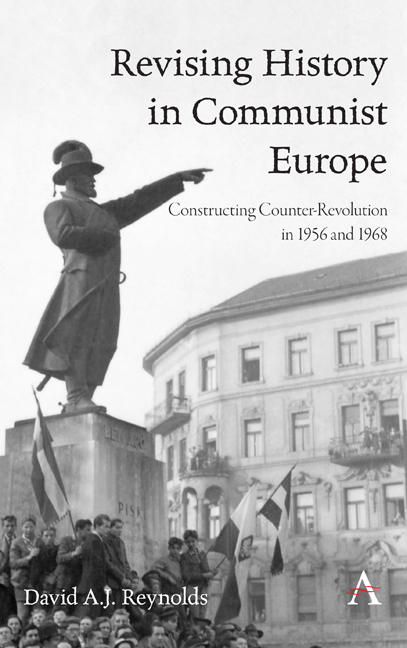Book contents
- Frontmatter
- Dedication
- Epigraph
- Contents
- Acknowledgements
- Introduction
- 1 The Export and Imposition of Stalinism
- 2 Hungarian De-Stalinization and Revising Recent History
- 3 A Revolution, a Counter-Revolution, or a National Uprising?
- 4 Stalinist Purges and De-Stalinization in Czechoslovakia
- 5 The Meaning of 1956 in 1968: March to June
- 6 June: Turning Point and the Hardening of Positions
- 7 July and August: Constructing Counter-Revolution
- 8 The Intentions of Intervention and the Shadow of 1956: Delusion and Failure
- Conclusion
- Epilogue
- Appendix
- Bibliography
- Index
3 - A Revolution, a Counter-Revolution, or a National Uprising?
Published online by Cambridge University Press: 16 February 2020
- Frontmatter
- Dedication
- Epigraph
- Contents
- Acknowledgements
- Introduction
- 1 The Export and Imposition of Stalinism
- 2 Hungarian De-Stalinization and Revising Recent History
- 3 A Revolution, a Counter-Revolution, or a National Uprising?
- 4 Stalinist Purges and De-Stalinization in Czechoslovakia
- 5 The Meaning of 1956 in 1968: March to June
- 6 June: Turning Point and the Hardening of Positions
- 7 July and August: Constructing Counter-Revolution
- 8 The Intentions of Intervention and the Shadow of 1956: Delusion and Failure
- Conclusion
- Epilogue
- Appendix
- Bibliography
- Index
Summary
In order for a mass uprising to be possible against a communist regime such as Hungary had in 1956, according to Vladimir Tismaneanu, two crucial foundations must exist. First, ‘communist elites must split on ideological and personal issues’. This was why, of course, Soviet visitors tended to lecture the MDP about restoring party unity, seeming not to appreciate that its disunity was a symptom, not the malady itself. This split was manifested and had broken out of the closet, most of all, over the issue of rehabilitations, pitting de-Stalinizing reformers led by Imre Nagy against those lingeringly implicated by Stalinism. A week after Rajk's reburial, Gerő reluctantly readmitted Nagy into the MDP, a feeble attempt to co-opt the gathering storm of opposition. Tismaneanu's second precondition for mass revolt – ‘the erosion of party authority’ – was likewise a phenomenon that the public repudiation of the regime at Rajk's graveside had exquisitely demonstrated.
The events that followed between 23 October and 4 November would resound with meaning, as we will see, in the Prague Spring 12 years later. But, since entire books could be written about each one of these days, we will focus for the purposes of this study, in addition to indispensable landmarks, on the surprisingly crucial process of defining and naming the uprising even as it took place. Definitions and categories matter because, to a large extent, they determine and justify how and why people and institutions behave as they do. When unprecedented incidents of resistance, protest, and revolt multiplied across Hungary, it was a phenomenon that demanded identification; people had to ask themselves what is this. And their answer to that question, as well as their ability to adapt their answer, conditioned their responses.
This process is complicated in a country ruled by a communist regime because, in Érvín László's words, ‘Communist ideology has annexed the greatest possible number of general concepts to suit its purpose.’ In other words, in a communist context, the regime has vigorously appropriated every contemporary political concept, assigning it an immovable position on one side or the other of the great communist– imperialist divide. Participating in, galvanizing, supporting, co-opting, redirecting, or opposing the uprising in Hungary required actors to master and manipulate the existing ideological lexicon or else selectively replace it by resurrecting older concepts and themes
- Type
- Chapter
- Information
- Revising History in Communist EuropeConstructing Counter-Revolution in 1956 and 1968, pp. 45 - 68Publisher: Anthem PressPrint publication year: 2020



